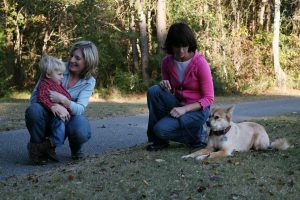Hope that you’re at the beginning of a terrific weekend, and in the middle of a wonderful summer! Your puppy or dog may be interacting with more people than usual including kids this time of year. Keep reading for dog and kid training suggestions!
Support Your Dog!
Safely Expose Your Puppy or Dog to Children…
– As soon as your puppy has appropriate vaccinations for field trips, you can begin exposing him to children. Scout locations out ahead of time so that you have a plan! When you arrive, stay out of the center of activity so that you have more control over how many children interact with your pup.
– Do bring along treats so that you can deliver them as your puppy interacts with children (helps to keep his mouth and sharp puppy teeth occupied as well as making the experience more positive!). You can also have kids drop treats on the ground, helping to keep your puppy grounded rather than jumping up. Teaching hand targeting i.e. the “touch” command is also terrific for polite greetings.
– Negative or poor experiences have the potential to create fear or anxiety, so if there are too many children, and your puppy seems overwhelmed, pack it up and go home! If your puppy is becoming overly excited, or if you feel that a particular child is too enthusiastic, you may want to wrap it up or at least take a break.
– Don’t force your puppy or dog to interact with a child, or allow a child to hug, pick up, or pet your puppy in an overbearing way. And if he growls or snaps, don’t punish, but instead find a qualified trainer or veterinary behaviorist to help!
– Remember that puppies need socialization until they’re approximately 2 years of age. Dogs who are 2 and up need socialization maintenance!
Learn to Read Your Dog
In Robin Bennett’s article, Why Supervising Kids and Dogs Don’t Work, she discusses the need for education on what constitutes good body language and what constitutes an emergency between a dog and child.
– Watch for loose body language. Your puppy or dog’s body should be loose and wiggly, even curvy. All good! What’s all bad? A stiff and tight body, and/or a closed mouth because panting has stopped. Calmly interrupt the interaction.
– Look for stress signals… Some basic signs of stress are yawning, lip licking, and half-moon eye. Half-moon eye, also called whale eye, occurs when a dog turns his head slightly away but his eye remains turned to the side. When this happens, the sclera (white part of the eye) appears as a crescent shape. Dogs showing half-moon eye are stressed and need immediate intervention and separation from a child. Note the stress signs in the dog pictured!
– Observe your puppy or dog when a child approaches. Does he turn away, move away, or back up? We all want our dogs to enjoy interacting with children, but if your dog chooses to remove himself when he feels uncomfortable, this is a WIN. Your dog is making a great choice! Just be sure to prevent the child from following your dog.
Support Your Child
How to Coach Your Child to Greet a Strange Dog…
– Coach your child to always ask if he can pet a dog before approaching the dog. Remind him not to lean over the dog close to the dog’s face.
– Show your child how to approach, then stand still, to allow the dog to sniff him. Remind him not to run up to the dog!
– If the dog is interested in being petted, your child can pet the dog under his chin or on his chest, or on his back. Remind him not to pet the dog on top of his head.
– If your child becomes excited, and squeals or shouts, remind him to use a quiet voice.
– If your child moves to hug or kiss the dog, intervene!
By Susan Marett









